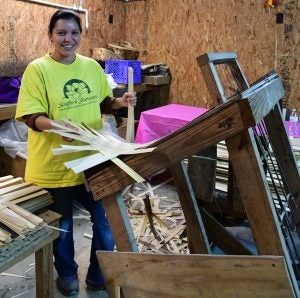
By JOYANNA LOVE/Editor
Chilton County loves its peaches. It is also home to a small factory that produces thousands of wooden baskets to hold the fruit.
The basket factory owned by Todd Hayes of Todd’s Produce and Gift Shop uses a “diamond shaped design” with thin metal handles for carrying.
“I don’t know of another … basket factory that makes this kind of basket,” Hayes said.
Hayes said there used to be another basket maker in Clanton, but now this is the only one.
“We kind of supply the state, so all the farmers get their baskets here,” Hayes said.
Customers have come from as far as Tennessee to buy a truck load of baskets.
“Some may buy 5,000 baskets. Some may buy 50,000 baskets. It just depends on the size of the farm,” Hayes said.
The baskets are also used to hold the peaches at Todd’s.
Hayes said production depends on how many orders the basket factory has.
The facility has been making baskets for years, even before Hayes was the owner.
Hayes said he was interested in owning the facility because of the number of basket’s they use for peaches.
In buying the business, Hayes also inherited the previous owner’s customers.
Hayes said they also supply a couple hundred baskets to church groups each year. The churches use them for gift baskets.
The baskets are made of poplar wood, and are primarily used for peaches. Each basket can hold anywhere from 15 to 25 peaches, depending on the size of the peaches. The basket factory makes an eight-quart size and a four-quart size basket.
Poplar logs are cut to the needed length and placed in a special machine toward the back of the building. This machine similar to a lathe shaves the log into long thin layers of wood. Hayes said the lathe does not work well with dry wood, so the wood has to be put on the machine before it gets too dry. These layers are then placed on a long table that feeds the sheets into a cutting machine. The machine cuts the sheets into strips of the needed size. Hayes estimates that both pieces of equipment are from the 1940s.
Employees weave 16 strips in a pattern similar to a mat using a specialized loom.
These mats are then formed around a mold. An employee braids the tops and cuts off any excess to achieve the desired shape.
This bottom portion of the basket is then stapled to a wooded band that helps to reinforce the oval shape of the top of the basket.
Nothing is added to the wood, so each basket maintains the natural color. Hayes said the basket factory does not make decorative baskets.
The final step is adding small metal handles. These are stapled to the base.
Once the baskets are finished, they are taken to a separate building where the wood dries out.
The baskets are stacked and tied together to prevent damage during shipping.
In addition to holding peaches for display, Hayes said the baskets are good to use when picking peaches.
